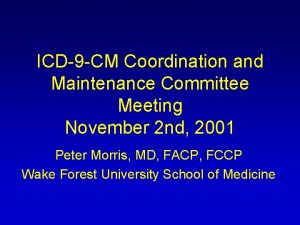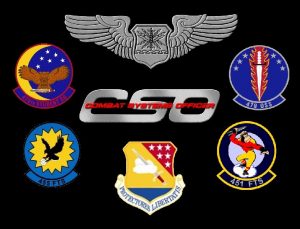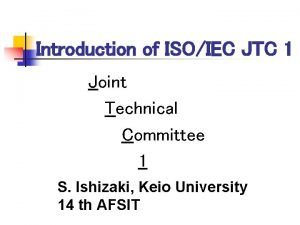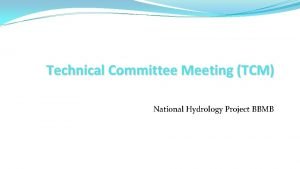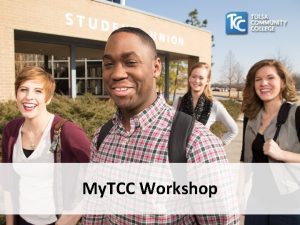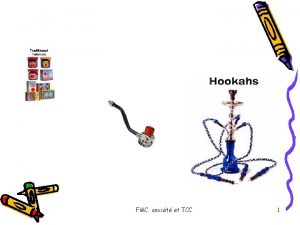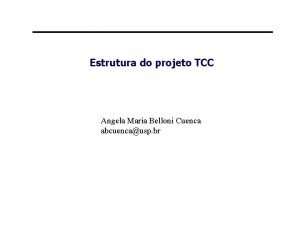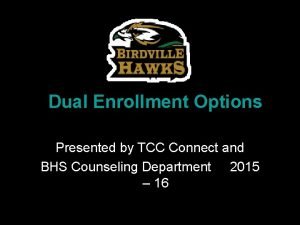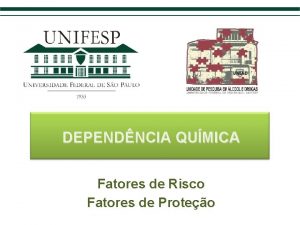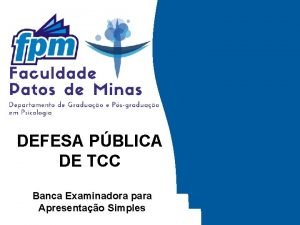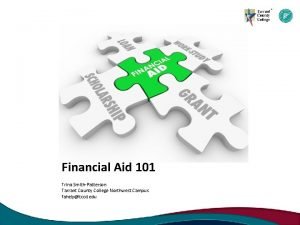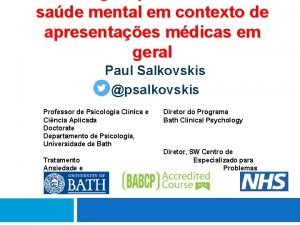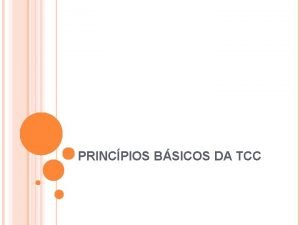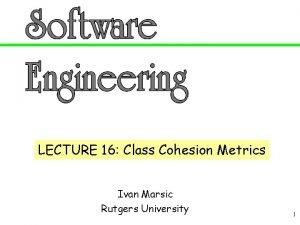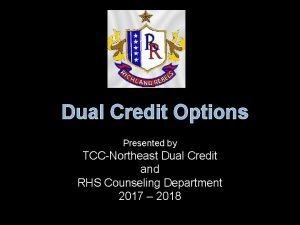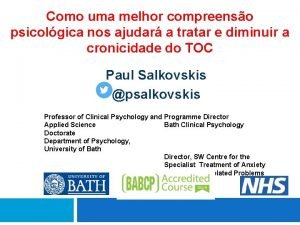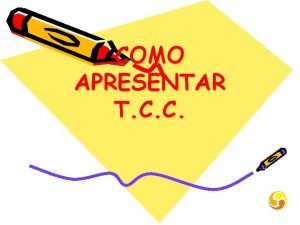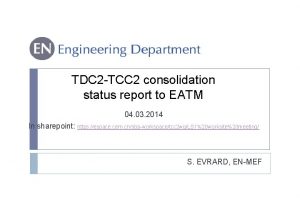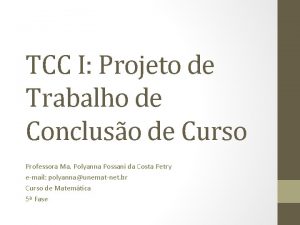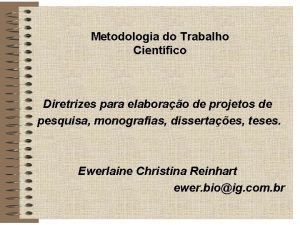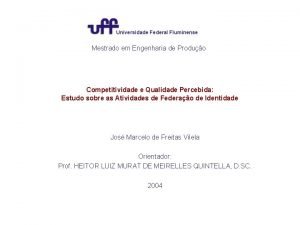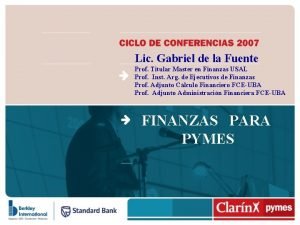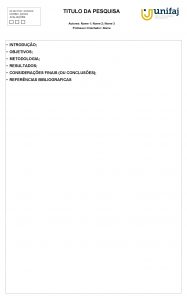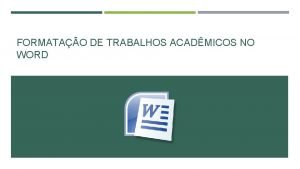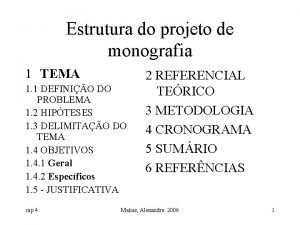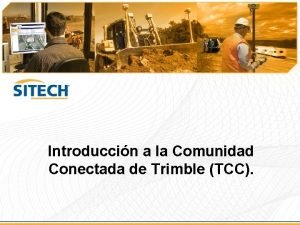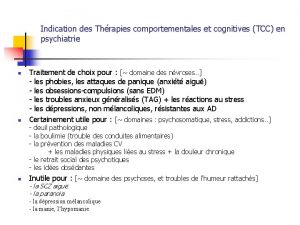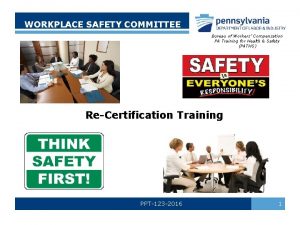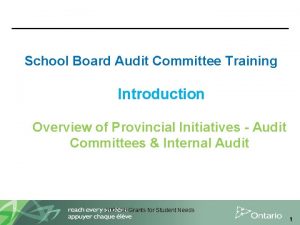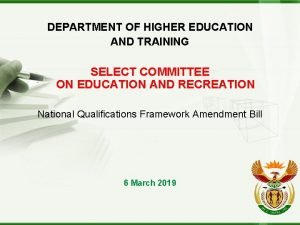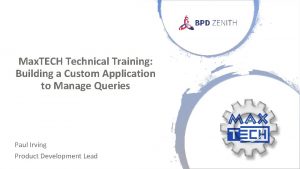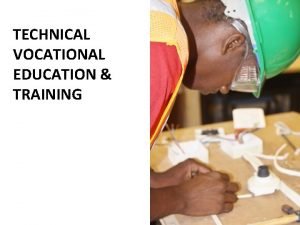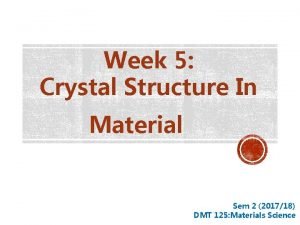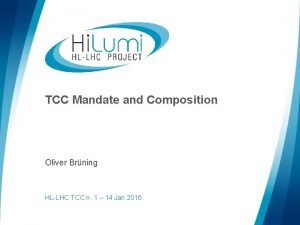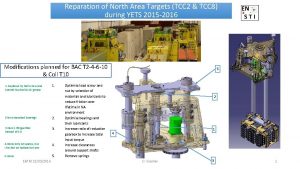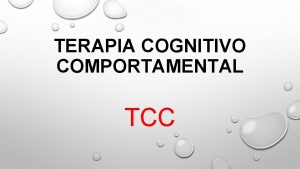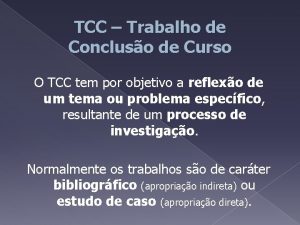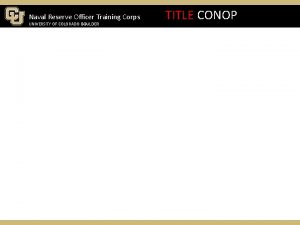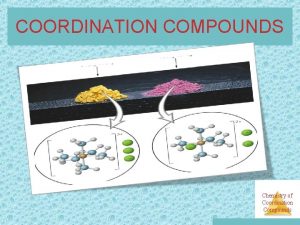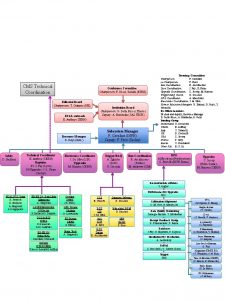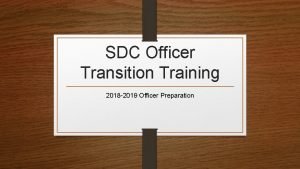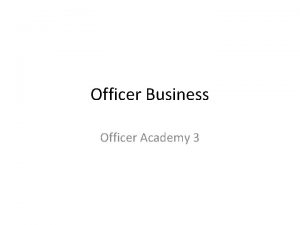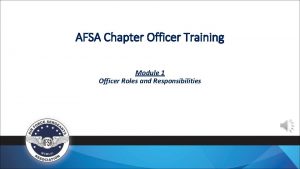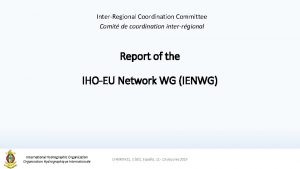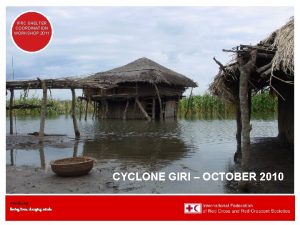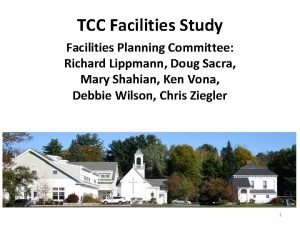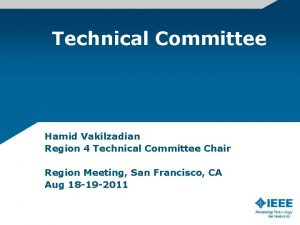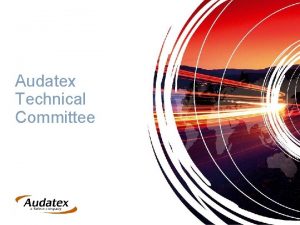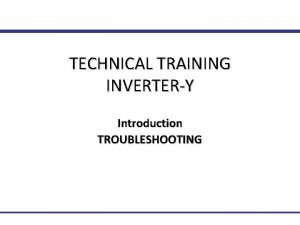Technical Committee Officer Training Technical Coordination Committee TCC





















































- Slides: 53

Technical Committee Officer Training Technical Coordination Committee (TCC)

NACE TECHNICAL COMMITTEE OFFICER TRAINING • Technical Committees • Organization and Operation • Officer Roles & Responsibilities • Procedures Overview • TEGs: TIE and Conference Programs • TGs: Preparation of Standards and Reports • Parliamentary Procedures

TECHNICAL COMMITTEE STRUCTURE

HOW ARE NEW TCC COMMITTEES FORMED? § Ideas usually come from members § Completion of Forms – Forms » TG-1 form completed by TG (For development of standards or reports) » TEG-1 form completed by TEG (For conducting TIEs and Symposia) – Fill out Need and purpose for standard or report, timeline, chair and vice chair § Voted on by STG Steering Committee § New STG Proposal sent to TCC and voted on by TCC

TECHNICAL COMMITTEE ORGANIZATION § Specific Technology Groups (STGs) – Oversee Task Groups (TGs) and Technology Exchange Groups (TEGs) – TGs—Write documents, e. g. , standards, reports, or other technical committee publications. – TEGs—Sponsor technical information exchanges (TIEs) and symposia at Annual Conference; also explore need for documents and symposia

TECHNICAL COMMITTEE OPERATIONS STG CHAIR RESPONSIBILITIES § Conduct STG meetings and STG Steering Committee meetings (TG and TEG officers) at least once/year – Ensure that STG Steering Committee members (TG & TEG Chairs) respond to committee letter ballots in a timely manner – Informally attend TG and TEG meetings to identify any issues; share responsibility with STG vice chair § Standards & Reports: – Ensure all procedures are followed in ballot process – Approve publication of standards and reports (with TCC chair) – Ensure 5 -year review of standards (and 10 -year on reports) § Appoint TG and TEG officers; ensure officer succession

OFFICER RESPONSIBILITIES § Be Familiar with Manuals – TCC and Technical Committees Operating Manual – TCC Publications Manual – Be familiar with Parliamentary Procedures § Plan Meetings – Set realistic agenda and submit to NACE – Anticipate leadership needs/succession – If the chair cannot make a scheduled meeting, the meeting cannot be cancelled. Get someone to take your place!! § Officer Information (e-mail, membership, etc. ) must be current § Inform NACE Staff and STG officer of any appointments or resignations

PROCEDURES OVERVIEW Technical Information Exchanges Conference Technical Programs Preparation of Standards

PROCEDURES OVERVIEW Technical Information Exchange § TIE may be run by TEG chair § Informal exchange of information – Presentations may be solicited or proposed » No formal papers permitted » NOT for commercial purposes » Normally planned, but walk-ins accommodated at discretion of chair – Short presentations followed by discussion

PROCEDURES OVERVIEW Technical Information Exchange § TIE topics may include: – Problem encountered, solution used or proposed – Case history, unusual failure, or solution – New technology or new application of existing technology – Other subjects of TIEs: Issues raised, Future plans for TEG, Recommendations to the STG, etc. § Topics could spur ideas for generation of standards, reports, symposia, future TIEs, etc.

PROCEDURES OVERVIEW TIE Chair Responsibilities § Ensures compliance with TIE guidelines (TCOM— Appendix A) § Stops speakers not in compliance § Pre-approves visual aids to be handed out – Presenter must provide the copies – No handouts of presentation text or “papers” § Provides written summary of TIE to NACE within four weeks

PROCEDURES OVERVIEW Conference Technical Programs § ACPC has responsibility § TEGs oversee conference technical programs – Symposia—paper presentations – Panel discussions – Combinations § Symposium chair appointed by STG chair § Program Coordinator works with symposium chairs

PROCEDURES OVERVIEW Task Groups and Standards § § § Task Group Chair Responsibilities Development of Standards Balloting Handling Negative Votes Revision, Reaffirmation, and/or Withdrawal of Standards

PROCEDURES OVERVIEW TG Liaison and What Staff Does § Introduce yourself to the NACE technical committee liaison/editor for your TG. – They can help you get started and avoid pitfalls. § What NACE staff does: – Advises committee officers on procedures – Edits drafts and sends standards out for ballot – Helps resolve and document handling of negative votes – Guides standard through approval and publication process § LACK OF COMMUNICATION with NACE staff and/or TG members is a big pitfall. Stay in constant touch.

PROCEDURES OVERVIEW Task Group Chair Responsibilities § Limit number of members on the TG (about 10) § Pick members who will – Provide good representation from industry – Provide good input and are knowledgeable – Responsible and responsive – Will be able to objectively handle controversial subjects § AVOID imbalance of categories of TG members § Get to know your vice chair, STG chair, and TG members

PROCEDURES OVERVIEW Task Group Chair Responsibilities § This is a consensus system, not 100% unanimous: – Listen to and capture comments – Give everyone a chance to provide input! § Chairs and vice chairs are only intended to be “facilitators. ” Do not come with an AGENDA. § Follow Roberts Rules of Order – Chair and/or vice chair MUST remain neutral on the proceedings. Your positions are facilitator and meeting documentation, respectively.

PROCEDURES OVERVIEW Pitfalls—Creating Document § Too much time to create a first draft: – It is helpful to have a working draft or outline prepared and distributed to TG members for review before the meeting. – Assign sections to different members or a few volunteers § Between meetings: – TG does not have to meet in person to discuss changes; consider monthly Web meetings to reduce time and maintain interest Contact your NACE liaison to set up conference calls § Be aware of deadlines, e. g. , to review negatives at CTW, make sure the ballot is out and completed before CTW § Style Manual: Be aware of terminology and style requirements. Check with liaison about common mistakes, e. g. , shall vs should

PROCEDURES OVERVIEW Interacting with Members § Consider sharing assignments with Vice-Chair – To balance workload, and – For vice chair to fill in when chair is not available § Members not responsive to assignments – Re-delegate, and/or – Remove member from TG (with support of STG chair) § Anticipate Leadership needs and officer succession

STANDARD DEVELOPMENT PROCESS Standard Published 3. 12. 5 Ratified or Approved by Appropriate Authority 3. 12. 4 Publication Approval Process Followed 3. 12 Idea for Standard Committee Formed to Write Standard Draft Prepared by Committee Standards must be reviewed every 5 years. Cycle starts over again with “revision” replacing “idea for standard. ” Draft Submitted to Headquarters for Ballot 3. 9. 1 Remaining Negative Voters Advised of Right to Appeal 3. 12. 1 Numbers indicate TCPM paragraphs Consensus Body Formed 3. 9. 2 Negative Votes on Reballot Addressed but Not Required to Be Resolved 3. 10. 6. 2 If 90% Affirmative vs. Negative (Excluding Abstaining) Votes, Reballot Passes 3. 10. 6. 3 Draft Distributed to Consensus Body for Ballot 3. 9. 4 Votes Analyzed-Valid Ballot? 3. 9. 4. 6 and 3. 9. 4. 7 If any Technical Changes or Unresolved Negative Votes, Draft Distributed to Consensus Body for Reballot 3. 10 TG Asks Negative Voters to Withdraw 3. 9. 6. 3 TG Addresses Negative Votes and Comments; May Revise Draft 3. 9. 6

PREPARATION OF STANDARDS Development of Consensus Body § Minimum of 50 members. If < 50 members on STG, members from other STGs must be identified § NACE staff distributes abstract and asks members if they wish to vote 4 week response time. § Respondents indicate interest classification to avoid “dominance. ” 7 classifications. § If > 50% in any one classification, more voters in other classifications must be solicited. § Consensus body = STG ballot list + interested parties (can be non-NACE members).

PREPARATION OF STANDARDS Handling Ballot Results § Understand method for handling negative ballots. – NACE liaison, STG chair, or Technology Coordinator can help § After ballot, Task Group: – Attempts to resolve all negative votes by e-mails, conference calls, personal contact, or – Invites negative voters to TG meeting § Administrative STG Chair: – Ensures TG demonstrates due diligence in following procedures

PREPARATION OF STANDARDS Handling Ballot Results § Know the difference between technical and editorial changes § Discuss with TG members before discussion with submitter or negative voter § Be sure to maintain written documentation of how the TG handled the negative vote and communicated with the negative voter, and whether it was resolved or not. – If resolved, does the negative voter want vote changed to affirmative or abstaining? Document this. § All negative voters must receive written disposition of comments and reasons, even if vote is resolved

Communication to a Negative Vote

Communication to a Negative Vote

Communication to a Negative Vote

PREPARATION OF STANDARDS Handling Negative Votes § Negative votes with only editorial or philosophical comments: – Recirculate to the sponsoring STG(s) with minutes from the TG meeting, or – STG meeting where negative was discussed – Minutes must document handling of vote § Negative votes not pertaining to the proposal need not be addressed – Recorded as “Negative Without Comment”

PREPARATION OF STANDARDS Handling Negative Votes § Reballot is required if unresolved negatives remain and/or technical changes are made § Only those paragraphs that have been technically changed since the last ballot shall be distributed § If there are 90% affirmative votes, excluding abstentions, Reballot passes and Standard can proceed to publication with unresolved negatives § Negatives must be addressed, but do not have to be resolved

PREPARATION OF STANDARDS Votes from Reballots § If voters don’t vote on reballot, their original vote stands § If voters didn’t vote on first ballot, but vote on reballot, vote on reballot stands § Voters may change vote on reballot, and that vote stands

STANDARDS PROCEDURES Revision, Reaffirmation, Withdrawal § Must be completed every five years § Begin review 1 -2 years before 5 -year date § Technology Coordinator and STG chair ensure that review is initiated § STG chair appoints ad hoc committee to review – If Reaffirmation is recommended, vote is by letter ballot – If Revision is recommended, TG formed (same procedures followed as for new standard)

STANDARDS PROCEDURES Withdrawal § If Withdrawal is recommended, ballot is sent to sponsoring STG members – Affirmative vote of 2/3 of sponsoring STG members with 50% return and < 50% of any one classification required § Automatic Withdrawal may occur if: – Committee is not showing measurable progress – Revision/reaffirmation is not completed by year 7 § STG should consider ramifications to industry if standard is withdrawn

PREPARATION OF REPORTS § Reports have Review and Comment step before ballot § REPORTS CANNOT MAKE RECOMMENDATIONS § Development of Consensus Body and Interest Classifications are similar to those for standards § All negatives do not have to be resolved, but must be addressed – Reballot is necessary if substance or intent of report altered on revised content

TECHNICAL COMMITTEE OFFICER TRAINING Parliamentary Procedures (Please use the Notes page format to review the answers to the questions on several subsequent slides)

PARLIAMENTARY PROCEDURES § Maintain Order § Protect the Rights of: – The Majority – The Minority – The Individual § Maintain Flexibility § Assure a Fair and Democratic Hearing § Ensure that the document development process will withstand any Procedural Challenges § Comply with the Bylaws

PARLIAMENTARY PROCEDURES § Code of Ethics § THE FUNDAMENTAL PRINCIPLES Members uphold and advance the integrity, honor, and dignity of the members’ profession by using their knowledge and skill for the enhancement of human welfare; being honest and impartial, and serving with fidelity the public, their employers, and clients; and striving to increase the competence and prestige of the corrosion engineering profession.

PARLIAMENTARY PROCEDURES THE FUNDAMENTAL CANONS § § § § A. Members shall hold paramount the safety, health, and welfare of the public in the performance of their professional duties. B. Members shall perform services only in the areas of their competence. C. Members shall continue their professional development throughout their careers and shall provide opportunities for the professional development of those members under their supervision. D. Members shall act in professional matters for each employer or client as faithful agents or trustees and shall avoid conflicts of interest. E. Members shall build their professional reputation on the merit of their services and shall not compete unfairly with others. F. Members shall associate only with reputable persons or organizations. G. Members shall issue public statements only in an objective and truthful manner. H. Members shall not maliciously injure the reputation, prospects, or business of others, but this does not remove the moral obligation to expose unethical conduct.

PARLIAMENTARY PROCEDURES § NACE International specifically prohibits sexual harassment by or against any employee, member, officer, director, or other volunteer, vendor, or customer; and such conduct will not be permitted or condoned

PARLIAMENTARY PROCEDURES Chair’s Responsibilities § § § Maintain Personal Neutrality Listen! Maintain Control Keep Discussion Focused If You Must Speak on a Motion: – Yield chair to next committee officer – Step away from rostrum

PARLIAMENTARY PROCEDURES Quorum: § TG: there is no quorum for task group meetings § But remember that you do need 2/3 majority of the members to approve a document before it goes out for STG Ballot. § STG’s quorum is 50% of the TG and TEG Chairs plus the STG Officers § OR 8 (whichever is less) to conduct business.

MOTIONS • A motion is a proposal that the committee take a stand or take action on some issue. • To be considered, a motion must be placed before the committee, and requires action by two members of the committee in session (or one guest but second by member): Procedure: • Present Motions: Member #1 Makes the Proposal: “I move that. . . ” • Second Motions: Member #2 Supports Proposal: “I second the motion. ” • Debate Motions • Vote on Motions • If the Chair needs to make a motion, he/she should step aside and yield his position to someone else

TYPES OF MOTIONS § Main Motions § Subsidiary Motions (Speaks directly to Main Motion and voted before Main Motion) – – – Amend Postpone (Indefinite or Definite) Limit or Extend Limits of Debate Previous Question Lay on the Table

ENDING DEBATE ON A MOTION § Chair: “If there is no further debate, we will vote on the motion. ” – If anyone objects, 2/3 affirmative vote required. § Any Member: “Mr. Chairman, I call the previous question. ” – Requires immediate vote to end debate — no second, no discussion. – 2/3 affirmative vote required to end debate and vote on motion.

AS CHAIR, WHAT DO YOU DO? § During debate on a main motion, discussion drifts away from the motion itself, whereupon another main motion is introduced and seconded. As chair, what do you do? § (A) Debate the new main motion, and then return to the previous one. § (B) Rule the new main motion out of order and return to the motion being debated

AS CHAIR, WHAT DO YOU DO? § During debate on a motion, a motion is made and seconded to amend it. As chair, what do you do? § (A) Continue debate on the original motion. § (B) Begin debate on the amendment. § (C) Debate both simultaneously.

AS CHAIR, WHAT DO YOU DO? § During debate on an amendment to a motion, a motion is made and seconded to amend the amendment in such a way as to negate its original intent. As chair, what do you do? § § § (A) (B) (C) (D) (E) Continue with the debate on the original amendment. Begin to debate the new motion to amend. Debate the original motion. Debate all three. Rule the new motion out of order. .

AS CHAIR, WHAT DO YOU DO? § During a committee report, the member reporting pauses and another member makes a motion. As chair, what do you do? § (A) Repeat the motion and ask for a second. § (B) Begin debate on the motion. § (C) Rule the motion out of order. (Why? )

AS CHAIR, WHAT DO YOU DO? § An issue raised during a committee report sparks a debate. As chair, what do you do? § (A) Allow debate to continue. § (B) Rule the debate out of order. § (C) Permit a member to make a motion.

AS CHAIR, WHAT DO YOU DO? § During debate on a motion, a member makes this motion: “I move to table the previous question. ” As chair, what do you do? § § (A) Ask for a second for the motion to table. (B) Ask for debate on the motion to table. (C) Immediately vote on the motion to table. (D) Rule the motion out of order and return to debate on the previous question. Why?

AS CHAIR, WHAT DO YOU DO? § Letter ballot results were 80% affirmative with a vocal minority. An open discussion is about to begin. A number of speakers and a lively debate are expected. As chair, you may: § (A) Rule that the amount of time any person can speak will be limited to MM minutes. § (B) Allow an individual to speak only once. § (C) Ask for a motion to limit debate.

AS CHAIR, WHAT DO YOU DO? § Prior to the luncheon recess, the committee voted on a motion to adopt certain wording in a document under consideration. § Now, after reconvening, with no other action on the floor, a member introduces a motion to reconsider that previous question. § As chair, what do you do?

AS CHAIR, WHAT DO YOU DO? § At a previous meeting, a motion was passed to hold a symposium at a future annual conference. Now, a motion is made not to hold that symposium. As chair, what do you do? § (A) Seek a second for the motion, then proceed to consider it as a new motion. § (B) Rule the motion out of order because: – it is a motion to reconsider. – it is a motion to rescind.

AS CHAIR, WHAT DO YOU DO? § At a previous meeting, a motion was adopted to hold a symposium at an upcoming annual conference, naming Mike Surefire and Jim Hotshot as chair and vice chair respectively. § At the current meeting, Mike announces that he is unable to fulfill his duties and resigns as chair. § What motion should be made?

AS CHAIR, WHAT DO YOU DO? § As chair, you recognize a non-committee member to speak on a motion on the floor. The speaker’s comments are in direct opposition to the position of the committee. As chair, what do you do? § (A) Rule the speaker out of order. § (B) Listen politely to the presentation and recognize someone else when the speaker is finished. § (C) Ask a committee member to rebut the speaker’s arguments.

ADDITIONAL RESOURCES § Committee Forms & Manuals http: //www. nace. org/Committees/Committee. Forms-and-Manuals/ § Technical Committees Operating Manual (TCOM) http: //www. nace. org/uploaded. Files/Committee s/TCOM%202014. pdf § Technical Committee Publications Manual http: //www. nace. org/uploaded. Files/Committee s/tech. Comm. Pub. Sept 2014. pdf § NACE Publications Style Manual http: //www. nace. org/uploaded. Files/Committee s/Style. Guideall. pdf § New Officer Handbook http: //www. nace. org/uploaded. Files/Committees /New-Officer-Handbook-2015. pdf § Technical Committee Directory http: //www. nace. org/Committees/Technical. Committee-Directory/ § Parliamentary Procedures Call 281 -228 -6264 for booklet § Officer Deadline Schedule http: //www. nace. org/uploaded. Files/Committees/ CTW%202015%20 Officer%20 Deadline%20 Schedul e. pdf § NACE/ASTM G 193 http: //www. nace. org/cstm/Store/Product. aspx? I D=6739 cfdb-e 581 -de 11 -ba 21 -0017 a 446694 e
 M(ab)3 optical isomers
M(ab)3 optical isomers Coordination and maintenance committee
Coordination and maintenance committee Lhc technical coordination
Lhc technical coordination Chief data officer training
Chief data officer training Casualty assistance officer army
Casualty assistance officer army Uct air force
Uct air force Joint technical committee 1
Joint technical committee 1 Technical committee on customs valuation
Technical committee on customs valuation Tcm technical committee meeting
Tcm technical committee meeting Tcc pre assessment activity
Tcc pre assessment activity Mytcc
Mytcc Tcc objetivos
Tcc objetivos Balance décisionnelle tcc
Balance décisionnelle tcc Resultados esperados de um projeto exemplo
Resultados esperados de um projeto exemplo Tcc connect
Tcc connect Plano de tratamento tcc
Plano de tratamento tcc Materiais e métodos tcc
Materiais e métodos tcc Introduçao tcc
Introduçao tcc Tcc northwest financial aid
Tcc northwest financial aid Rapa nui idioma
Rapa nui idioma Tcc
Tcc Inferência arbitrária tcc
Inferência arbitrária tcc Ivan marsic rutgers
Ivan marsic rutgers Tcc dual credit
Tcc dual credit Tcc
Tcc Como apresentar tcc em 20 minutos
Como apresentar tcc em 20 minutos Tcc emial
Tcc emial Conclusão tcc
Conclusão tcc Tcc workspace 365
Tcc workspace 365 Conclusão tcc
Conclusão tcc Tcc lyceumstraat
Tcc lyceumstraat Exemplo de metodologia
Exemplo de metodologia Introdução abnt exemplo
Introdução abnt exemplo Tcc y tcv
Tcc y tcv Web tcc faj
Web tcc faj Referência bibliográfica abnt
Referência bibliográfica abnt Espaço entre linhas abnt
Espaço entre linhas abnt Tcc estrutura
Tcc estrutura Monografia
Monografia Conclusão pronta
Conclusão pronta Tcc ecr
Tcc ecr Tcc
Tcc Tcc lyceumstraat
Tcc lyceumstraat Trimble tcc
Trimble tcc Balance décisionnelle tcc
Balance décisionnelle tcc Pa safety committee requirements
Pa safety committee requirements Audit committee training
Audit committee training Select committee training
Select committee training Max technical training
Max technical training Definition of technical vocational
Definition of technical vocational Training is expensive without training it is more expensive
Training is expensive without training it is more expensive Perbedaan on the job training dan off the job training
Perbedaan on the job training dan off the job training Aggression replacement training facilitator training
Aggression replacement training facilitator training Bcc crystal structure
Bcc crystal structure

